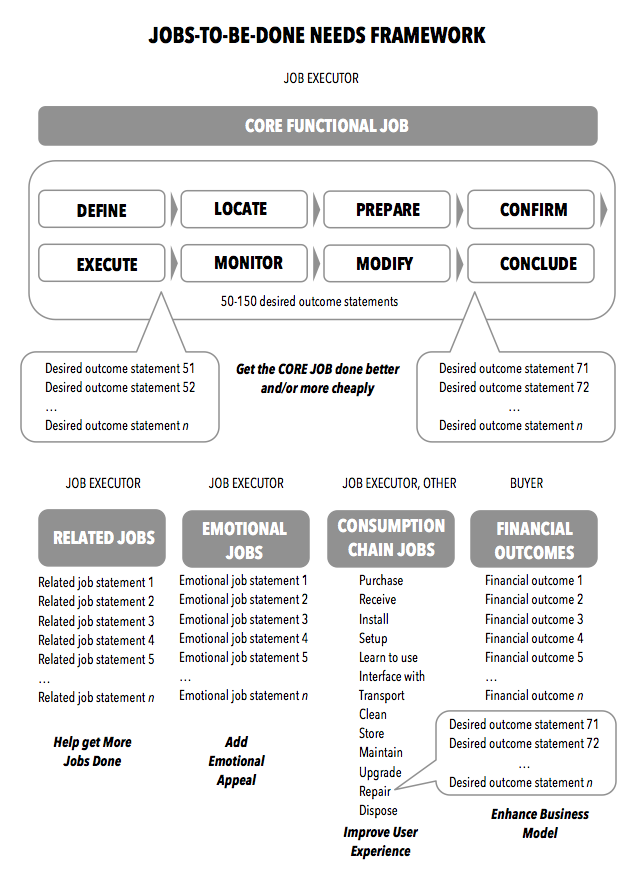As I have mentioned elsewhere, the Jobs-to-be-Done Needs Framework introduces the types of customer needs that must be considered to gain a deep understanding of what a customer is trying to accomplish. They include (i) the core functional Job-to-be-Done, (ii) the desired outcomes tied to the core functional Job-to-be-Done, (iii) related jobs, (iv) emotional and social jobs, (v) consumption chain jobs, and (vi) the buyer’s financial desired outcomes.

While a job describes the overall task the customer is trying to execute, an outcome is a metric the customer uses to measure success and value while executing a job. For every functional and consumption chain job there exists a set of up to 50 or more desired outcome statements.
The customers’ needs are multilayered and complex. Customers have needs related to buying, using, and owning a product. They have emotional and functional needs. Customer need statements are mutually exclusive—they are defined independent of each other. A complete set of needs is collectively exhaustive—it incorporates all the needs a customer has for a given job.
Each need must be stated separately and categorized correctly. Why?
The goal of innovation is to devise solutions that address unmet customer needs. For a company to be successful at innovation, this means it must not only know all the needs in the market, but it must be able to determine which needs are unmet. It must also be able to determine if there are segments of customers with different unmet needs. These are the insights that enable the innovation process to become more predictable. Without these insights innovation remains a game of chance. Having them changes everything.
What are the chances, for example, that a company will randomly conceptualize a solution that addresses 14 unmet needs in a segment of the market that represents about 25 percent of users? It’s very unlikely to happen by chance. A company would have to know the segment exists and precisely what needs are underserved before it could predictably achieve success.
But how long would it take a product planning team to conceptualize a solution that addresses those same 14 unmet needs if they knew the segment existed and exactly what those unmet needs were? In the case of the Bosch circular saw product team (see the case study in chapter 5), it took just 3 hours. This is the power of the Outcome-Driven Innovation (ODI) process. Innovation is transformed from a game of chance to a science when the customer’s desired outcomes (customer metrics) are known in advance of ideation.
One important factor that cannot be overlooked is that most markets are not homogeneous—meaning in nearly every market, customers do not agree on what needs are unmet. Some customers in nearly every market struggle more than others to get a job done. This confirms what we learned in marketing 101—in nearly every market exists segments of customers with unique sets of unmet needs.
Discovering segments of customers with unique sets of unmet needs and determining precisely what unmet needs exist in a segment requires statistically valid market research, not just observation or other qualitative research methods. Customer personas that are built around demographic and psychographic data and claim to represent customer “segments” are highly misleading as they usually create phantom targets.
Trying to guess at what needs-based segments exist and which needs are unmet introduces risk and variability into the innovation process. This is why statistically valid quantitative research is an essential part of the ODI process.
All of this begins with understanding what a need is and what type of needs customers have. The Jobs-to-be-Done Needs Framework provides an important function. Given all the customer insights that companies consider each day, the framework reveals what inputs are needed, how they should be categorized and organized, why they are captured, and how they should be used. The framework brings order to a historically chaotic practice.
Learn more >>
JOBS TO BE DONE: Theory to Practice
by Anthony Ulwick
IDEA BITE PRESS October 25, 2016
